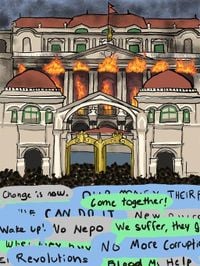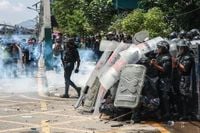In the heart of Kathmandu, a pirate flag—famously flown by the Straw Hat Pirates in the anime One Piece—fluttered alongside Nepal’s national banner as smoke rose from government buildings and the shouts of young protesters echoed through the streets. This was not the scene of a film set or a pop culture convention, but the epicenter of Nepal’s most dramatic political upheaval in decades, a youth-led revolt that toppled the government in early September 2025 and left the world asking: how did a generation raised on memes and short videos become the architects of a revolution?
The answer, according to reporting from Bloomberg, The News Minute, and other regional outlets, lies in the collision of digital culture, deep-seated inequality, and the unmet promises of Nepal’s postwar democracy. The so-called “brain rot” generation—dismissed by political elites as apathetic and glued to their phones—channeled their online savvy into a powerful, decentralized movement that forced Prime Minister K.P. Sharma Oli and several senior ministers to resign on September 9, 2025. By September 12, former Chief Justice Sushila Karki was appointed interim Prime Minister, her selection emerging from both establishment circles and a grassroots Discord server poll that attracted over 7,700 participants.
The spark that ignited the protests was, fittingly, digital. In late August and early September, short videos and viral images began circulating on TikTok and Instagram under hashtags like #NepoKids and #PoliticiansNepoBabyNepal. One especially incendiary photo showed the son of a government minister posing beside a Christmas tree built entirely from Louis Vuitton and other luxury brand boxes. For a country where the per capita income hovers around $1,400 a year and one in four lives in poverty, the image was a gut punch—a symbol of nepotism and the yawning gap between the political elite and everyday Nepalis.
“We are bound by the chains of unemployment, trapped by the selfish games of political parties. Corruption has woven a web that is extinguishing the light of our futures,” declared 16-year-old Avishkar Raut in a TikTok speech back in March, his words echoing through protest marches months later. The online outrage quickly spilled into Kathmandu’s streets, as thousands of young Nepalis—many college students—organized via Discord, Telegram, and VPNs to circumvent government censorship and bans on 26 major social media platforms, including TikTok, Instagram, WhatsApp, and Facebook.
The government’s attempt to shut down these platforms, following an August 17 Supreme Court order demanding registration of social networks, was meant to curb fake accounts and hate speech. Instead, it was perceived as a direct assault on free speech and daily life—especially for families separated by migration, who rely on WhatsApp and Facebook to stay in touch. “The ban was like pulling the plug on daily life,” said Sunita, 27, whose brother works in India. “My mother talks to him on WhatsApp every night. Suddenly, they put a stop to that. We felt that the government was cutting us off from our families.”
With over 40% of Nepal’s population between 16 and 40, and youth unemployment above 20%, the sense of betrayal was palpable. The country has one of the highest rates of social media use per capita in South Asia, and for many, these platforms aren’t just for entertainment—they’re lifelines, job markets, and organizing tools. “We already knew our leaders were corrupt, but when they tried to censor us, it felt like they were taking away our freedom to even speak,” explained Anish Rai, a 24-year-old computer science graduate.
Within hours of the ban, the digital generation found workarounds. VPNs and private Discord servers became virtual town squares, buzzing with debate, planning, and solidarity. Memes, satirical posters, and TikTok routines became the language of dissent, turning the symbols of state repression into emblems of resistance. Protesters wore cosplay, livestreamed demonstrations, and waved the One Piece flag—a nod to a global fandom, but also a pointed symbol of rebellion and the hunger for freedom.
On September 8, the anger boiled over. Thousands marched on government complexes, chanting anti-corruption slogans and demanding accountability. The mood was determined but peaceful—until police opened fire with live rounds. According to The News Minute, the violence escalated rapidly: government buildings, the Parliament, ministries, the offices of Kantipur Media Group, and even the Prime Minister’s residence were set ablaze. The wife of a former prime minister was critically injured when their home was torched. In total, over 70 people were killed—many of them young participants—making it the deadliest unrest Nepal has seen in decades.
The government’s heavy-handed response, including the use of live ammunition, rubber bullets, and mass arrests, only fueled the protests. Soldiers patrolled the streets under curfew, and the main government complex was set on fire. In a dramatic twist, 13,500 prisoners escaped after their jails were damaged during the chaos. The scale of destruction and loss was staggering, but so was the clarity of the protesters’ message: enough was enough.
Despite the violence and tragedy, the movement retained its irreverent, meme-fueled spirit. Videos showed demonstrators waving flags atop government buildings, dancing to TikTok routines in front of burning offices, and even returning stolen goods. A British travel vlogger, Harry, captured the mayhem as he stumbled into the protests: “I couldn’t believe what I was seeing.” Meanwhile, resentment toward Indian media covering the protests boiled over, with viral clips showing young Nepalis confronting and ejecting reporters accused of biased or inaccurate coverage.
After Prime Minister Oli’s resignation, the movement shifted back online. The Hami Nepal Discord server swelled to over 145,000 members, evolving into a chaotic digital parliament where users debated, organized, and even proposed candidates for interim leadership. While the final decision rested with the army and establishment, the selection of Sushila Karki as interim Prime Minister was seen as a nod to the movement’s digital roots and its demand for accountability.
But as the smoke cleared, the deeper crisis remained. Nepal’s democratic experiment, launched after a brutal civil war and the abolition of the monarchy in 2008, had promised peace, equality, and development. Instead, many young Nepalis saw only broken promises, elite entrenchment, and a political system out of touch with their realities. The decentralized, youth-driven uprising—part meme, part manifesto—was less about ideology and more about a loss of trust in the entire architecture of power.
“People are still mourning those they lost, and as citizens of this country, we have a responsibility to remember them,” said protest organizer Tanuja Pandey. “Mental health is important, but at this moment justice is more important. The media has a major role to play in shaping how this is remembered and understood.”
Nepal’s September uprising showed that even in societies long accustomed to inequality, the digital age can turn envy and outrage into real-world action. Whether the new government can heal the wounds and deliver on the dreams that fueled the revolution remains to be seen. For now, the pirate flag still waves over Kathmandu—a reminder that, in the age of Instagram and TikTok, revolutions can begin with a meme and end with the fall of a government.

